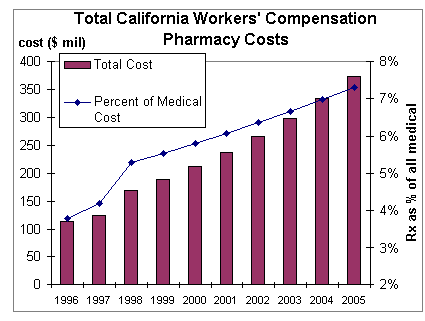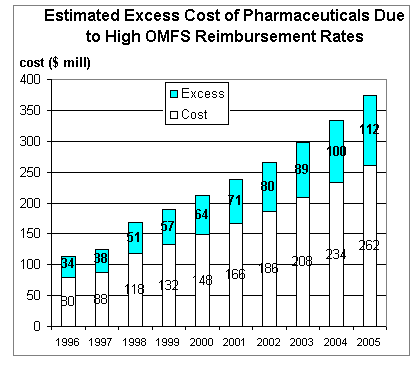

|
| weblog/wEssays archives | home | |
|
A Drug Industry Running Amok (June 12, 2006)  Astute reader Richard C. responded to my pharmaceutical spoof (Zombiestra) with
this question: "Guess which drug was the most heavily advertised in 2000?
Astute reader Richard C. responded to my pharmaceutical spoof (Zombiestra) with
this question: "Guess which drug was the most heavily advertised in 2000?
Hint 1: The patients would have been far better off spending their money on Pepsi or Budweiser, not to mention a Dell computer. Hint2: The drug had the all too frequent side effect of death." I guessed Viagra (some people have been rumored to die while enjoying the drug's effects) but Richard reports that the answer is Merck's recently withdrawn Vioxx, with a stunning ad/promotion budget of $160 million. To place pharma industry ad spending in context, Richard supplied the following quote: Pharmaceutical companies spent $2.5 billion in 2000 on mass media ads for prescription drugs. What part of overall advertising spending is that? A small portion. U.S. companies spent $101.6 billion advertising consumer products in the “mainstream” U.S. mass media in 2000. That includes internet ad spending of $2.9 billion. Thus, DTC prescription drugs ads represent 2.5% of overall mass media ad spending.I am sure the numbers for 2005 far exceed those for 2000.  The reality of "the drug trade's" profiteering can be seen in these charts of
pharmaceutical spending in the California Workers Compensation program:
The Cost of Pharmaceuticals in Workers’ Compensation.
As the cost of drugs has tripled in just 10 years , one wonders if this massive increase in
spending has improved the health of the recipients--or just the health of the industry's bottom line.
The second chart shows the state's estimate of "excess cost"--i.e. the drug industry's
rip-off of the Workers Compensation system ($112 million in 2005 alone). This is, of course, a relatively small piece
of the overall healthcare spending in the state. The mind boggles at what the "excess cost"
number would be for the entire nation.
The reality of "the drug trade's" profiteering can be seen in these charts of
pharmaceutical spending in the California Workers Compensation program:
The Cost of Pharmaceuticals in Workers’ Compensation.
As the cost of drugs has tripled in just 10 years , one wonders if this massive increase in
spending has improved the health of the recipients--or just the health of the industry's bottom line.
The second chart shows the state's estimate of "excess cost"--i.e. the drug industry's
rip-off of the Workers Compensation system ($112 million in 2005 alone). This is, of course, a relatively small piece
of the overall healthcare spending in the state. The mind boggles at what the "excess cost"
number would be for the entire nation.
The pharmaceutical industry claims that rip-off prices are necessary to fund horribly costly research and development, but a close analysis of this claim reveals a disturbing reality: all these companies spend far more hyping their drugs than they do researching new ones. For a balanced view, please read What Does R&D Really Cost? which details how some startup companies do in fact spend a vast amount of money getting their drug through safety/efficacy trials. But the "big pharma" companies don't fare as well: The pharmaceutical industry's trade group, Pharmaceutical Research and Manufacturers of America (PhRMA), has long maintained that developing a single new drug and bringing it to market takes on average 12-15 years and costs $500 million. A new report by Public Citizen, a consumer group founded by Ralph Nader, estimates the pre-tax cost of bringing a new drug to market during the nineties was only about $107M. After taxes, they say, the outlay on research and development (R&D) for each successful drug (which must also cover expenses for unsuccessful candidates) could be as low as $71M. PhRMA immediately responded by quoting new estimates upping their figure to $700M. Here is my personal story on pharmaceutical rip-off pricing. Due to my fair skin and massive sun exposure as a child and youth, my dermatologist prescribes a topical cream, fluorouracil, for me every few years to burn off the solar keratoses (pre-cancerous lesions) which form on sun-damaged skin. Ten years ago, the cost of a tube of this 30-year old medication was $40. It has now skyrocketed to $240 a tube. I repeat: This is for a 30-year old medication. Exactly what R&D costs are being amortized by a six-fold increase in price after 30 years? The answer is obviously none--the medication is long off patent. It's simply a case of the medical establishment not really caring what the cost is as long as insurance pays the tab. As a self-employed person, I pay my own bare-bones insurance (Kaiser Permanente) and all my own drug, dental and eye-care expenses at full retail, i.e. what the insurance carrier pays but the fully insured person never even sees. The annual cost for "full insurance coverage" of all healthcare expenses would eat up most of my total annual after-tax income (self-employed people also have to pay their own Social Security taxes)--and I am hardly alone in not being able to pay for "fully insured healthcare coverage." Some 45 million Americans have zero healthcare coverage, a number which seems to grow at a far faster rate than the overall population. For a deeper exploration of drug costs in a non-U.S. setting (Manitoba, Canada), check out High Cost Users of Pharmaceuticals: Who Are They?. For more on this subject and a wide array of other topics, please visit my weblog. copyright © 2006 Charles Hugh Smith. All rights reserved in all media. I would be honored if you linked this wEssay to your site, or printed a copy for your own use. |
||
| weblog/wEssays | home |